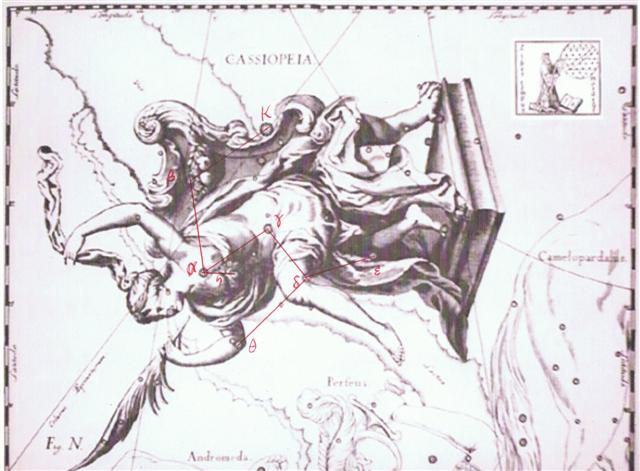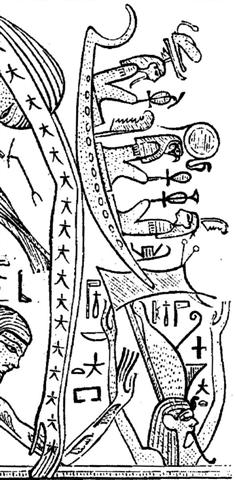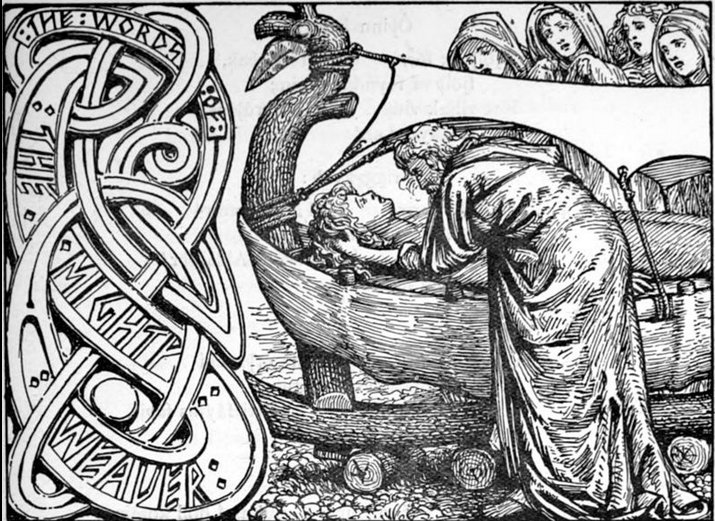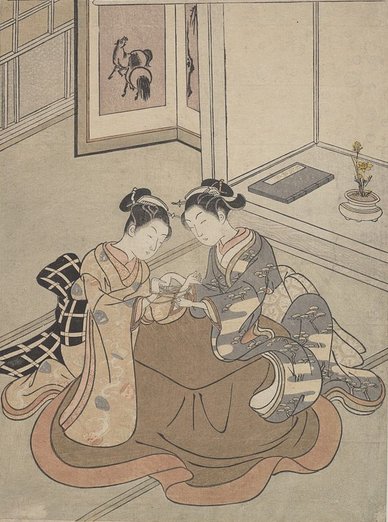15-7. Leaving aside for the moment
the dates given in Manuscript E we should now continue beyond
the Corner of the House (tara):
 |
 |
 |
 |
|
Eb5-35 (326 + 184
= 510) |
Eb6-1 (185) |
Eb6-2 (193 - 7) |
Eb6-3 (513 →
19 * 27) |
|
Kua pipiri te hetu |
ko te mata no te henua |
to ihe - te maro |
tara |
|
Piri. 1. To join (vi, vt); to meet
someone on the road; piriga, meeting,
gathering. 2. To choke: he-piri te gao. 3.
Ka-piri, ka piri, exclamation: 'So many!'
Ka-piri, kapiri te pipi, so many shellfish! Also
used to welcome visitors: ka-piri, ka-piri!
4. Ai-ka-piri ta'a me'e ma'a, expression used
to someone from whom one hopes to receive some news,
like saying 'let's hear what news you bring'. 5.
Kai piri, kai piri, exclamation expressing:
'such a thing had never happened to me before'.
Kai piri, kai piri, ia anirá i-piri-mai-ai te me'e
rakerake, such a bad thing had never happened to
me before! Piripiri, a slug found on the
coast, blackish, which secretes a sticky liquid.
Piriu, a tattoo made on the back of the hand.
Vanaga. 1. With, and. 2. A shock, blow. 3. To stick
close to, to apply oneself, starch; pipiri,
to stick, glue, gum; hakapiri, plaster, to
solder; hakapipiri, to glue, to gum, to coat,
to fasten with a seal; hakapipirihaga, glue.
4. To frequent, to join, to meet, to interview, to
contribute, to unite, to be associated, neighboring;
piri mai, to come, to assemble, a company, in
a body, two together, in mass, indistinctly; piri
ohorua, a couple; piri putuputu, to
frequent; piri mai piri atu, sodomy; piri
iho, to be addicted to; pipiri, to catch;
hakapiri, to join together, aggregate,
adjust, apply, associate, equalize, graft, vise,
join, league, patch, unite. Piria; tagata
piria, traitor. Piriaro (piri 3 -
aro), singlet, undershirt. Pirihaga,
to ally, affinity, league. Piripou (piri
3 - pou), trousers. Piriukona,
tattooing on the hands. Churchill.
.jpg)
Tara. 1. Thorn: tara miro. 2.
Spur: tara moa. 3. Corner; te tara o te
hare, corner of house; tara o te ahu,
corner of ahu. Vanaga. (1. Dollar; moni
tara, id.) 2. Thorn, spike, horn; taratara,
prickly, rough, full of rocks. P Pau.: taratara,
a ray, a beam; tare, a spine, a thorn. Mgv.:
tara, spine, thorn, horn, crest, fishbone.
Mq.: taá, spine, needle, thorn, sharp point,
dart, harpoon; taa, the corner of a house,
angle. Ta.: tara, spine, horn, spur, the
corner of a house, angle. Sa.: tala, the
round end of a house. Ma.: tara, the side
wall of a house. 3. To announce, to proclaim, to
promulgate, to call, to slander; tatara, to
make a genealogy. P Pau.: fakatara, to
enjoin. Mq.: taá, to cry, to call. 4. Mgv.:
tara, a species of banana. Mq.: taa, a
plant, a bird. Ma.: tara, a bird. 5. Ta.:
tara, enchantment. Ma.: tara, an
incantation. 6. Ta.: tara, to untie. Sa.:
tala, id. Ha.: kala, id. Churchill |
|
Oct 7 (280) |
8 |
9 (100 + 182) |
10 |
...Possibly Eb5-35
was designed to visualize how the
Sun at the horizon would be seen
reflected as in a mirror by the
surface of the water. We can compare
with Ba7-12:
|
 |
*45.7 |
 |
|
Aug 22 (234) |
Oct 7 (280) |
|
ADHAFERA
(*154.7) |
σ Virginis (*200.4) |
|
|
No star listed (18) |
ADHIL
(Garment's Train) = ξ Andromedae
(19.3),
θ
Ceti (19.7) |
KSORA (Knee) = δ Cassiopeiae
(20.1), ω Andromedae (20.6), γ Phoenicis (20.8) |
δ Phoenicis (21.5) |
|
April 8 (108) |
9 |
10 (100) |
11 (365 + 101 = 466) |
|
... It is known
that in the final battle of the gods, the massed
legions on the side of 'order' are the dead
warriors, the 'Einherier' who once fell in combat on
earth and who have been transferred by the Valkyries
to reside with Odin in Valhalla - a theme much
rehearsed in heroic poetry. On the last day, they
issue forth to battle in martial array. Says
Grimnismal (23): 'Five hundred gates and forty
more - are in the mighty building of Walhalla -
eight hundred 'Einherier' come out of each one gate
- on the time they go out on defence against the
Wolf.' That makes 432,000 in all, a number of
significance from of old. This number must have had
a very ancient meaning, for it is also the number of
syllables in the Rigveda. But it goes back to
the basic figure 10,800, the number of stanzas in
the Rigveda (40 syllables to a stanza) [40 *
270 = 10800] which, together with 108, occurs
insistently in Indian tradition, 10,800 is also the
number which has been given by Heraclitus for the
duration of the Aiōn, according to Censorinus (De
die natali, 18), whereas Berossos made the
Babylonian Great Year to last 432,000 years. Again,
10,800 is the number of bricks of the Indian
fire-altar (Agnicayana) ... |
 |
Beyond the Corner we will find another Rei, a week after the first
one in the Shark sequence. 181 + 7 = 188:
 |
 |
 |
 |
 |
 |
|
Eb5-29
(178) |
Eb5-30 →
2 * 265 |
Eb5-31
(360 / 2) |
Eb5-32 (181) |
Eb5-33
(364 / 2) |
Eb5-34
(366 / 2) |
|
e manu gao takoa |
e
manu kake
rua |
te tagata |
e Rei vage Rei |
manu |
tagata |
|
Gao. 1. Neck. 2.
Glans penis (te gao o te kohio), neck
of penis. Vanaga. Neck, throat, (naho
G); gao pukupuku, scrofula; hore
te gao, to cut the head off; arakea
gao, scrofula. Gaogao, calm.
Gaoku, to eat greedily. Gaopu, to
choke on a bone. Churchill.
Ta. OR. Write,
writing. The name of writing before the term
rongorongo in 1871 became current.
Fischer. 1. To tattoo ( = tatú), to
tattoo pictures on the skin, also: he-tá
ite kona, tá-kona. 2. To weave (a net):
he-tá i te kupega. 3. To shake
something, moving it violently up and down
and from one side to the other; he-tá e
te tokerau i te maga miro, the wind
shakes the branches of the trees; also in
the iterative form: e-tá-tá-ana e te
tokerau i te tôa, the wind continuously
shakes the leaves of the sugarcane. 4. To
pull something up suddenly, for instance, an
eel just caught, dropping it at once on a
stone and killing it: he-tá i te koreha.
Tá-tá-vena-vena, ancient witching
formula. Vanaga. 1. Of. 2. This, which. 3.
Primarily to strike: to sacrifice, to
tattoo, to insert, to imprint, to write, to
draw, to copy, to design, to color, to
paint, to plaster, to note, to inscribe, to
record, to describe, number, letter, figure,
relation; ta hakatitika, treaty;
ta igoa, sign; ta ki, secretary;
ta kona, to tattoo; ta vanaga,
secretary. Churchill. ... the root ta
through its long series of known
combinations carries a strongly featured
sense of action that is peripheral,
centrifugal, and there seems to be at least
a suspicion of the further connotation that
the action is exerted downward ... The
secondary sense of cutting will easily be
seen to be a striking with a specialized
implement, and we find this sense stated
without recognition of the primal striking
sense only in Mangareva, Nukuoro, Viti, and
Malekula. In Indonesia this secondary sense
is predominant, although Malagasy ta
may come somewhat close to the striking idea
... Churchill 2.
Koa. 1. Rori te
koa hogihogi, to follow a scent. 2. Joy.
Koakoa, joy, content, happiness, gay,
satisfaction, hilarity, mirth, to leap for
joy, to please, to fondle, dear; ariga
koakoa, good-humored; hakakoakoa,
to rejoice, to leap for joy. P Pau.: koa,
contented, pleased; koakoa, joy.
Mgv.: koakoa, rejoicing, joy, mirth,
to be content, satisfied; koa, to
mourn. Ta.: oaóa, joy, gladness.
Churchill. Pau.: Koari, to languish,
to fade. Mgv.: koari, half-cooked.
Mq.: koaí, rotten, insufficiently
cooked. Koata, a mesh. Ta.: oata,
hole in coconuts, etc. Mq.: oata,
crevice. Churchill. Mgv.: Koai, a
plant. Ta.: oai, the wild indigo.
Ma.: koai, a plant.
Akakoana-kohatu, to make a small
shapeless hole. Ma.: kohatu, stone.
Koata, light of the moon shining
before the moon rises. Ha.: oaka, a
glimpse of light. Churchill.
Kake. Kakea, to come
near, to embark. P Pau.: kake, to
climb, to ascend. Mgv.: kake, the
arrival of shoals of spawning fish. Mq.:
kake, to climb up a valley. Ta.: ae,
to climb, to ascend. Churchill. Mgv.:
kake, to strike on an ocean reef. Ta.:
ae, to strand. Churchill. Sa.: a'e,
upward, to go up; sa'e, to elevate
one leg, as in the act of falling in a club
match; 'a'e, to ascend, to rise. To.:
hake, upward, to ascend. Fu.: ake,
up, to ascend; sake, ro raise the leg
at one in derision or mockery; kake,
to climb, to ascend. Niuē:
hake,
up, going up. Uvea: ake,
up; kake,
to go up. Ma.: ake,
upward; kake,
to climb, to ascend. Mq.: ake,
on high, upward; kake,
to ascend. Mgv.: ake,
upward. Bukabuka: ake,
up. Ta.: ae,
up, to go up, to ascend, to climb. Ha.:
ae,
to raise, to lift up, to mount. Fotuna:
no-jikijiake,
to lift up; no-tukake,
to stand upright. Nukuoro: kake,
to go up. Nuguria: kake,
up; hanage,
northwest. Rapanui: kake a,
to go abroad. Vi.: thake,
upward; thaketa,
to dig or lift up. Churchill 2.
Rua.
1. Two; second; other (precedes
the noun); te rua paiga, the other
side. 2. Hole, grave; holes in the rocks or
between the rocks of the coastal lagoons;
he keri i te rua, to dig a hole. 3. To
vomit. Vanaga. 1. Two. P Mgv., Ta.: rua,
id. Mq.: úa. 2. Nausea, seasickness,
to vomit, disgust; hakarua, to vomit,
to spew. PS Mgv.: aruai, ruai,
to vomit. Mq.: úa, id. Ta.: ruai,
id. Pau.: ruaki, id. Sa.: lua'i,
to spit out of the mouth; lulua, to
vomit. To.: lua to vomit. Fu.:
lulua, luaki, id. Niuē:
lua,
id. Viti: lua,
id.; loloa,
seasick. 3. Cave, hollow, ditch, pit, hole,
beaten path, grave; rua papaka,
a ditch. P Pau.: rua,
a hole. Mgv.: rua,
a hole in the ground, ditch, trench. Mq.:
úa,
dish, hole, cavern. Ta.: rua,
hole, opening, ditch. Churchill.
Ta.:
ruahine, an
old woman. Ma.: ruahine,
id. Ta.: ruaroa,
tropic of Capricorn. Mq.: uaoa,
a constellation, the eleventh month. The
sense in Tahiti is probably that of some
constellation which may be used to determine
the position. Ta.: ruau,
an old man, an old woman. Ha.:
luau, a
parent. Churchill. |
|
Oct 1 |
2 (275) |
3 |
4 |
5 (273 +
5) |
6 |
|
"Aug 17 |
18 |
19 |
20 (236) |
21 (278 - 41) |
22 |
|
JULY 29
(210) |
(211) |
(212) |
(213) |
(214 =
278 - 64) |
(215) |
 |
|
CIH (Whip)
= γ Cassiopeiae,
λ Tucanae (12.4),
φ³ Ceti (12.6), μ Andromedae (12.8)
*336.0 = *12.4 - *41.4
→
4 * 84 |
φ4 Ceti (13.2) |
No star listed (14) |
1h (15.2)
β
Phoenicis (15.1),
υ
Phoenicis,
ι
Tucanae (15.6),
η
Ceti,
ζ
Phoenicis (15.7) |
Al Batn Al Hūt-26 (Belly of the Fish) /
Revati-28 (Prosperous)
/
1-iku (Field Measure)
MIRACH (Girdle) =
β
Andromedae,
KEUN MAN MUN (Camp's South Gate) = φ
Andromedae(16.0),
ANUNITUM =
τ
Piscium
(16.5),
REVATI (Abundant) = ζ Piscium
(16.9)
REGULUS
(α Leonis) |
ν Phoenicis (17.4), κ Tucanae
(17.6)
*159.0 + *182.0 = 341.0 |
|
... Now
birds and fishes are born under the sign of
the Yin, but they belong to the
Yang. This is why birds and fishes both
lay eggs. Fishes swim in the waters, birds
fly among the clouds. But in winter, the
swallows and starlings go down into the sea
and change into mussels
... |
|
April 2 |
3 (2 *
229) |
4 |
5 |
6 (96,
461) |
7 |
|
...
Though Andromeda has its roots most firmly
in the Greek tradition, a female figure in
Andromeda's place appeared in Babylonian
astronomy. The stars that make up Pisces and
the middle portion of modern Andromeda
formed a constellation representing a
fertility goddess, sometimes named as
Anunitum or the Lady of the Heavens
...

The Girdle of
Andromeda (β
Mirach, *16.0) coincided with the night in
which Regulus
culminated → †.
 |
...Then the big Fish did swallow
him, and he had done acts worthy of blame.
Had it not been that he (repented and) glorified
Allah, He would certainly have remained inside the
Fish till the Day of Resurrection. -
Qur'an, chapter 37 (As-Saaffat),
verse 139–144.
But We cast him forth on the
naked shore in a state of sickness,
And We caused to grow, over him,
a spreading plant of the gourd kind.
And We sent him (on a mission) to a hundred thousand
(men) or more.
And they believed; so We permitted them to enjoy
(their life) for a while. - Qur'an, chapter 37
(As-Saaffat), verse 145–148 ...

 |
 |
 |
 |
 |
|
Eb6-4 (188 = 181 + 7) |
Eb6-5 |
Eb6-6 |
Eb6-7 |
Eb6-8 |
|
ihe Rei |
kupega no
te niu |
te tagata |
te rima haga rave
hia |
te kava - te rakau |
|
Kupega. He-tá i te kupega, to
weave (a net). Hopu kupega, those who help
the motuha o te hopu kupega in handling the
fishing nets. Huki kupega, pole attached to
the poop from which the fishing-net is
suspended. Mata kupega, mesh. Te matu'a o
te kupega, part of a net from which the weaving
started. Te puapua kupega, the upper part of
a fishing net. Tau kupega, rope from which
is hung the oval net used in ature fishing.
Tuku kupega, a fishing technique: two men
drag along the top of a fishing net doubled up,
spread out on the bottom of a small cove, trapping
the fish into the net. Vanaga. |
|
Oct 11 (284) |
12 |
13 |
14 |
15 (288) |
|
υ Andromedae (22.9) |
ACHERNAR (End of the River) =
α
Eridani
(23.3),
χ
Andromedae (23.6),
τ
Andromedae (23.9) |
ALSEIPH (Scimitar) =
φ
Persei
(24.5),
τ
Ceti (24.7) |
No star listed (25) |
ANA-NIA-10 (Pillar-to-fish by)
χ
Ceti (26.1),
POLARIS =
α
Ursae Minoris,
BATEN KAITOS (Belly of the Fish) =
ζ
Ceti
(26.6),
METALLAH =
α
Trianguli
(26.9) |
 |
|
April 12 |
13 |
14 (104) |
15 |
16 |

...
Not
only the Sun-gods, but the stars, were supposed to travel in
boats across the firmament from one horizon to the other.
The under-world was the abode of the dead; and daily the
sun, and the stars which set, died on passing to the regions
of the west or Amenti, below the western horizon, to
be born again on the eastern horizon on the morrow. In this
we have the germ of the Egyptian idea of immortality
...
In this perspective it would be useful to divide
timespace by imaginary straight lines ('strings')
corresponding to the right ascension positions. Then,
perhaps not straight away but much later, declination lines
would follow and complete the Net of Nut - part of which was
the Desert Lynx (Caracal),
the high-jumping creature who was catching birds in flight:

And after having created such a net this could then be
thought of as a great celestial loom, for inserting the coloured
stars.

... Five days of illumination, called the
'Lighting of the Flame' (which in the earlier reading of
this miracle play would have followed the quenching of the
fires on the dark night of the moon when the king was
ritually slain), preceded the five days of the festival
itself; and then the solemn occasion (ad majorem dei
gloriam) commenced. The opening rites were under the
patronage of Hathor. The king, wearing the belt with her
four faces and the tail of her mighty bull, moved in
numerious processions, preceded by his four standards, from
one temple to the next, presenting favors (not offerings) to
the gods. Whereafter the priesthoods arrived in homage
before his throne, bearing the symbols of their gods. More
processions followed, during which, the king moved about -
as Professor Frankfort states in his account - 'like the
shuttle in a great loom' to re-create the fabric of his
domain, into which the cosmic powers represented by the
gods, no less than the people of the land, were to be woven
...
There had to be a pair of celestial nets because also the
southern night sky had to be mapped.


And from the southern perspective the stars would be like
fishes and the net would be a fishing net.
... The principal word for 'fish' in most
Dravidian languages is min, which has an ancient
homophone meaning 'star', both probably derivatives of the
root min 'to glitter' ... Fish are actually unable to
close their eyes, and the fact that 'when the fish sleeps it
does not close its eyes' was noticed by ancient Indians. The
dot-in-a-circle similar to that occuring among the trefoils
of the Harappan priest-king's robe is identical with the eye
of the many small hare- and fish-shaped amulets discovered
on the lower levels of Harappa ...
Metoro may have
thought of Polaris - the Pillar to Fish from - when he said
kupega no te niu for the glyph 4 days earlier.

|
.jpg)


















